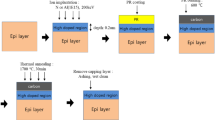Abstract
Nickel monosilicide (NiSi) is an attractive alternative to the currently used silicides for the coming generations of deep submicron complementary metaloxide-semiconductor (CMOS) devices. This silicide material has a resistivity, which is comparable to that of TiSi2 or CoSi2, but consumes less silicon for its formation. The silicide silicon interface is relatively planar and, unlike TiSi2, its resistivity does not change with the linewidth for narrow lines. However, the thermal stability of NiSi is relatively poor at the currently used temperatures during process integration. Recent studies have shown that the stability of these films could be increased substantially through the small addition of alloy elements, which do not increase the resistivity of the NiSi film. Morever, it has been demonstrated that the addition of a small amount of alloy elements significantly reduces diode leakage, possibly due to the suppression of silicide spike formation as a result of alloy addition. This paper will present and discuss the details of these experimental results.
Similar content being viewed by others
References
T. Ohguro, S. Nakajima, M. Koike, T. Morimoto, A. Nishiyama, Y. Ushiku, T. Yoshitomi, M. Ono, M. Saito, and H. Iwai, IEEE Trans. Electron Devices 42, 2305 (1994).
F. Deng, R.A. Johnson, P.M. Asbeck, S.S. Lau, W.B. Dubbelday, T. Hsiao, and J. Woo, J. Appl. Phys. 81, 8047 (1997).
R. Mukai, S. Ozawa, and H. Yagi, Thin Solid Films 270, 567 (1995).
D. Mangelinck, J.Y. Dai, S.K. Labiri, C.S. Ho, K.L. Pey, and T. Osipowicz, MRS Spring Meeting Warrendale, PA: MRS, 1999).
Klaus, Graff, Metal Impurities in Silicon-Device Fabrication, Springer Series in Materials Science, Springer, NY, p. 75–82 (1995).
P.J. Grunthaner, F.J. Grunthaner, and A.J. Madhukar, J. Vac. Sci. Technol. 20, 680 (1982).
F.M. d'Heurle, C.S. Petersson, J.E.E. Baglin, S. LaPlaca, and C.Y. Wong, J. Appl. Phys. 55, 4208 (1984).
J. Barto;abs and L. Tesar; Phys. Status Solidi A 122, 607 (1990)
S. Tanaka, K. Matsushita, and H. Kitagawa, Jpn. J. Appl. Phys. Part 1 35, 4624 (1996).
Y.K. Kwon, T. Ishikawa, and H. Kuwano, J. Appl. Phys. 61, 1055 (1987).
K.S.R.K. Rao, S.V. Pandu, Rangaiah, P.N. Reddy, and B.P.N. Reddy, J. Appl. Phys. 85, 2175, (1999).
M. Seibt and W. Schröter, Phil. Mag. A. 59, 337 (1989).
B. Laurent, D. Mangelinck, B. Pichaud, A. Lhote, and J.B. Quorin, Solid State Phenom. 37–38, 157 (1994).
M. Liehr, P.E. Schmid, F.K. LeCones, and P.S. Ho, Phys. Rev. Lett. 54, 2139 (1985).
Because the forward current in good diodes is dominated by electron diffusion in the p+ neutral region, the saturation current Is can be expressed by Is=AqDnnpo/WP+, where A is the diode junction area, q is the electron charge, Dn is electron diffusion coefficient, npo is equilibrium electron concentration in the p+ regions, and Wp+ is the width of the p+ neutral region. Noting Dn α Tμ n and npo α T3 exp (−Eg/KT) and also that, for high dopant concentration Na (1018−1019 cm−3), the electron mobility μn is almost independent of temperature in the neightborhood of 300 K, the temperature dependence of saturation current is given by Is α T4 exp (−Eg/KT) with Eg as the bandgap and K as the Boltzmann constant.
F.A. Padovani and R. Stratton Solid-State Electron. 9, 695 (1966).
Author information
Authors and Affiliations
Rights and permissions
About this article
Cite this article
Chi, D.Z., Mangelinck, D., Zuruzi, A.S. et al. Nickel silicide as a contact material for submicron CMOS devices. J. Electron. Mater. 30, 1483–1488 (2001). https://doi.org/10.1007/s11664-001-0162-4
Received:
Accepted:
Issue Date:
DOI: https://doi.org/10.1007/s11664-001-0162-4




